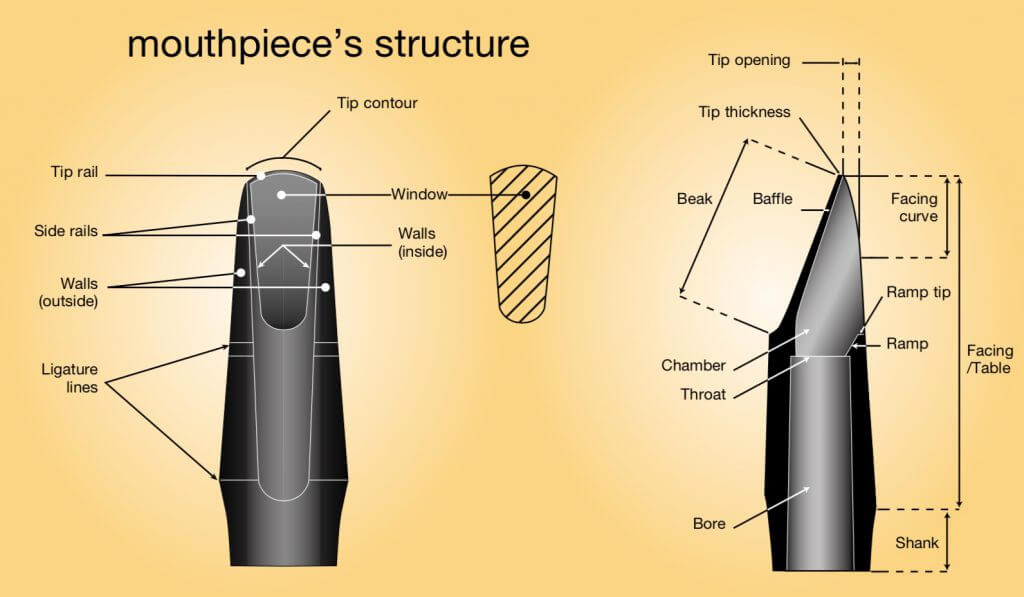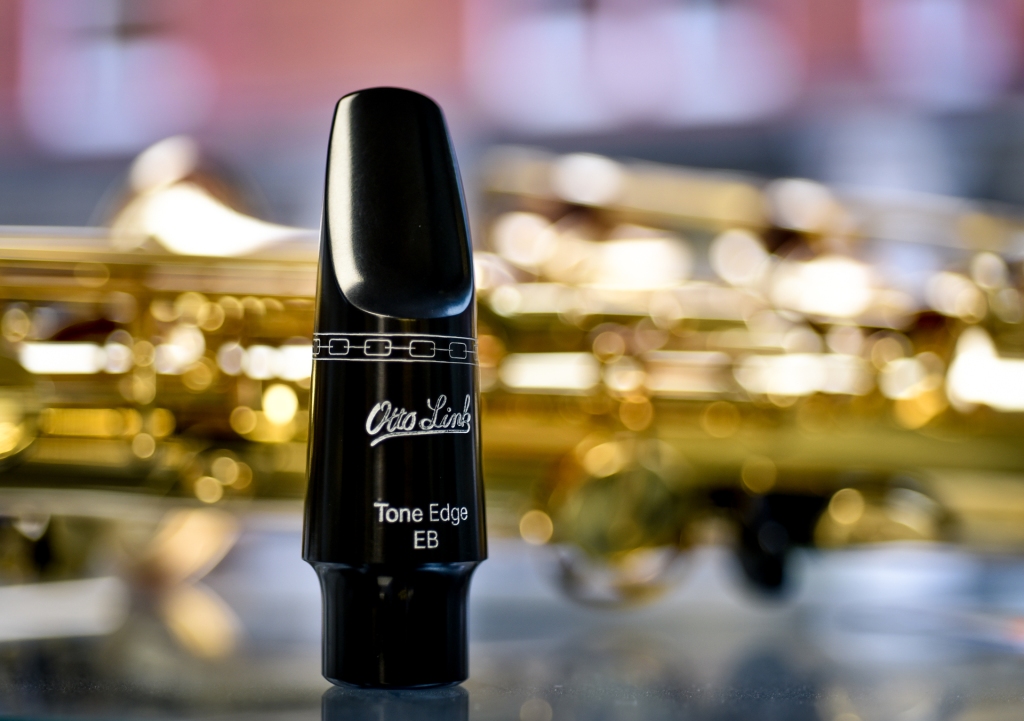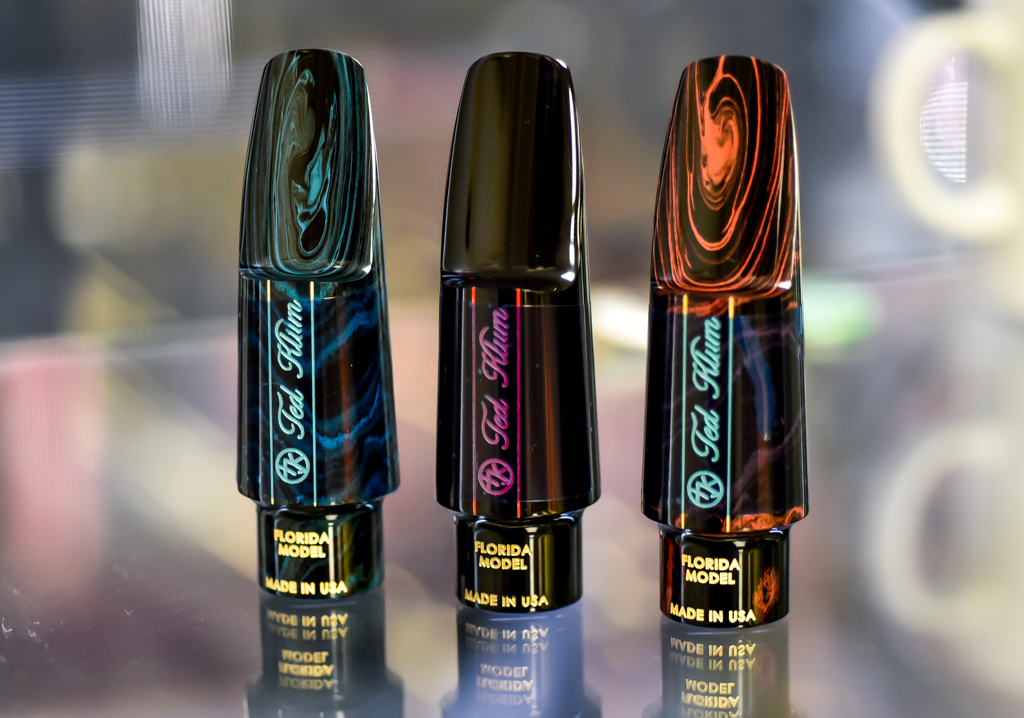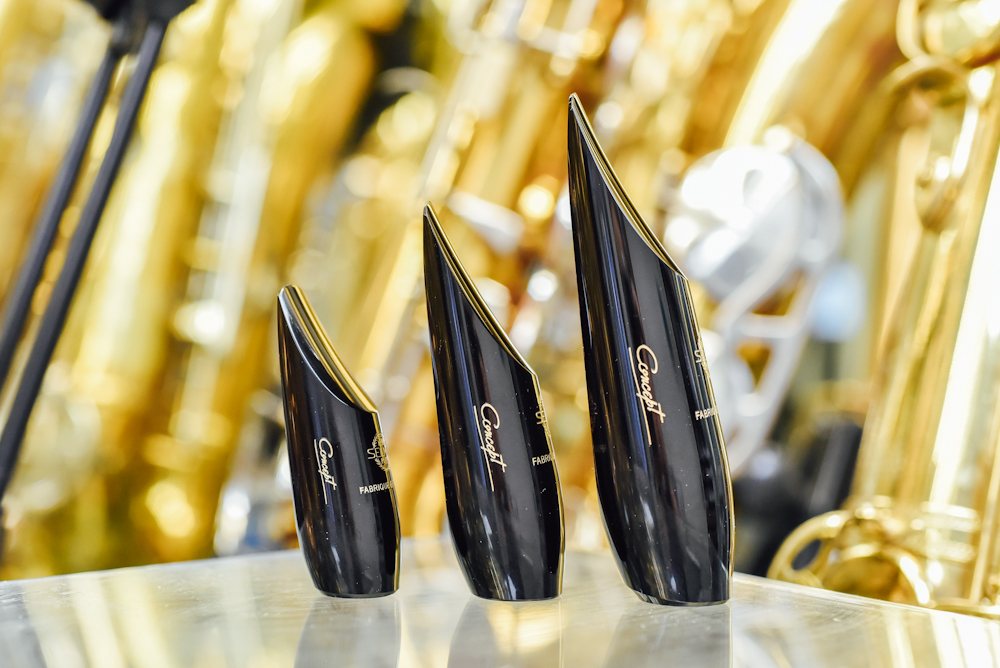Choosing a Saxophone Mouthpiece
The mouthpiece of a Saxophone, be it Soprano, Alto, Tenor, Baritone or more, is the most customisable part of the instrument; a variable perfectly dedicated to the individual player themselves. So, how do you choose a mouthpiece? How do you know when you’re ready to move on from the plastic mouthpiece you start off with, and how can you tell how a mouthpiece is going to sound, simply by looking at it? These are all questions that are going to be answered!
I’ve always found something magical about mouthpiece shopping, right from when I was young till now. It’s like that scene in Harry Potter and the Philosopher’s Stone, where Harry chooses his wand at Ollivander’s. Where I used to be Harry, being handed an array of pieces to try out, experiment on and generally have fun with, now I’m Olivander, helping customers find ‘The One’ that’ll help build their identity as a musician for hopefully years to come. Doing that is something that I quite enjoy, understanding a musician’s vision for themself, and helping to bring it to life. And mouthpieces aren’t simple! No single element of each piece will create a specific sound. Mouthpieces are a combination of factors coming together cohesively. For example, a wider tip opening (the distance between the reed and the mouthpiece tip) on its own does help create a bigger sound as more air is let through, but if the chamber, and bore of the mouthpiece are fairly small then this will focus your air, and counter the wider tip opening.
Mouthpiece anatomy
The diagram below will help you know exactly what I’m talking about when I name a specific part of the mouthpiece!

Firstly, the facing curve which is made up of the tip and the tip rails. It controls the response of the mouthpiece. Longer facings are often less resistant, providing you with a particularly free-blowing mouthpiece with less ‘back pressure’. This makes the lower notes of the sax easier to play as well as making playing softer easier. On the other hand, shorter facings tend to make the response much more defined and favour the higher pitches as well as the altissimo range. Similarly, the thinner the tip rails, the faster the response. Thicker tip rails are often used in beginner mouthpieces as they prevent some squeaking in the early stages of learning. A medium curve with a little bit of resistance built in might be seen as optimal because having something to blow against will actually give you more control over the sound, rather than your sound controlling you!
Secondly, the baffle. The baffle is perhaps the most important feature of the mouthpiece and can have the most influence over the sound. It controls the aerodynamics of the mouthpiece. Mouthpiece baffles come in three main designs:

The straight baffle is at a constant angle with the table of the mouthpiece. The effect of this is that it has a consistent sound across all registers and will rarely sound bright or harsh. This is because the air stream is unaffected as a result of a more open space leading to the Chamber.
The roll-over baffle is one where the angle between tip and table changes. It is at its highest towards the tip, often even blending into the tip rail. This adds more overtones to your playing as the air stream goes at many different speeds through the mouthpiece. A unique quality provided by such a baffle is that sound from a roll-over initially seems brighter whilst also having the straight baffle sound beneath.
The step baffle is the brightest of the three. It resembles a stairway step, forming an internal wedge in the mouthpiece. The tight space at the top of the baffle focuses the air stream, making it speed up as it travels through the mouthpiece. It also has the most projection out of all the baffle types. It was popularised by Dave Guardala with his famous Michael Brecker model and is also very common in all R&B and rock and roll playing to enable the sax to cut through the rest of the band. It also faces a drawback however, as it always sounds thin, but in my experience can be toned down by a stronger, darker reed.
The concave baffle is not a common type. It has a hollow indentation just below the tip rail. It produces a very dark sound and is coupled with a serious lack of projection.
Thirdly, the chamber. Alongside the baffle, the chamber ties for the most important and influential factors of the mouthpiece when analysing the effects they have on the ultimate sound. The chamber is the open area in the middle of the mouthpiece, and directly below where the reed sits. It defines the acoustics of the mouthpiece by creating the fullness or focus of the sound. Theo Wanne likens small and large chambers to the difference between a spotlight and a floodlight. The facing curve and the baffle can fine-tune the way a mouthpiece responds and sounds but they will always be at the mercy of the shape and size of the chamber! A large chamber will have a more spread sound than a small chamber, but it will also be more flexible and thus more dependent on the player to define the sound. This is perfect for a musician that has firmly cultured their sound and musical identity. But size isn’t the only variable when studying mouthpiece chambers. The precise shape also matters immensely. Notwithstanding the fact that the chamber doesn’t just affect sound, but it also affects intonation. Most important to the chamber is to remember that neither is objectively superior or inferior to the other.
A small chamber is made when the chamber has a smaller diameter than the bore of the mouthpiece (the tunnel that attaches the mouthpiece to the crook of the saxophone). A small chamber mouthpiece cinches in the interior shape of the mouthpiece. This creates an extra ‘pop’ and energy to the sound, as well as a quicker response time. This is because, like a step baffle, it focuses the air stream before then re-spreading it into the bore. The air stream becomes focused, and coherent. In fact, the small chamber is often used in conjunction with a high baffle, to double-down on the bright sound. Jazz type mouthpieces generally tend to have smaller and more square chambers as these encourage a greater production of higher overtones, creating more “edge” or brilliance to the tone, and are often also played with larger tip openings for the added power.
A medium chamber is made when the chamber has the same diameter as the bore. The medium chamber was popularised by Meyer Bros in the late 1940s. Even nowadays, most alto sax mouthpieces use a medium chamber. This is because the medium chamber enables a full sound with a focused centre. The chamber is rather allowing the sound to develop itself rather than having too much of a bearing on it. Though medium chambers do not have the same fatness on the bottom end that large chambers do, they are still open and don’t sound thin or even flimsy.
A large chamber is made when the chamber has a larger diameter than the bore. This is characterised by a visible lip in the mouthpiece when looking down the beak that highlights the bore being smaller. The very first mouthpieces that were made by Adolphe Sax in 1841 had large chambers, and this design feature was the primary chamber design up until the 1960s when manufacturers started making smaller chambers. A vast majority of tenor saxophonists played with large chamber mouthpieces in the 1950s and 1960s. These are considered to be ‘True Large Chamber’ pieces, as in the 1970s to present, many mouthpieces are described as having large chambers, despite the chamber not actually being larger than the bore.
Knowing all of this will help you understand a mouthpiece’s sound, response and projection before you even put it on your sax!
How do you know when you’re ready to move on from the plastic mouthpiece?
For woodwind, most student and beginner mouthpieces are made from plastic. These pieces focus more on supporting the musician, rather than influencing their personal sound. This is to help the intrepid new player discover their musical identity. Do they want to focus more on jazz, classical, solo or ensemble playing, or maybe they want to keep a hand in every jar! These are all things that we look at when choosing a mouthpiece, and are worth bearing in mind when you’re upgrading your own setup (or forking out for your child’s new setup!).
The ideal time to upgrade your mouthpiece is around Grades 4-5 (and marks a great reward for passing). This is because it helps the musician further develop their musical identity. Consider it like taking the training wheels off a bike. The most common mouthpieces for players looking for their first upgrade are made of hard rubber or ebonite. The material is tough and sturdy, but that doesn’t mean it’s invincible and even the slightest chip, crack or dent can have a massive influence on the sound. Hard rubber mouthpieces are perfect for someone’s first upgrade as they are much easier to play on than metal pieces.
When choosing your first mouthpiece, you shouldn’t be looking to get particularly wide tip openings. This is because a beginner will have a harder time getting a sound out of it. Although the larger openings enable a bigger sound because of the greater space between tip and reed, this only works if you can support it! It should also be noted that after a point, certain smaller tip openings do not exist as there wouldn’t be enough room for the reed to vibrate.
Some recommendations for beginner mouthpieces are the Selmer S80, and the Vandoren AL series. All of which give the musician more freedom to culture their personal tonal identity whilst not pushing the player towards jazz, or classical styles. These are great mouthpieces to ask for when opening the Pandora’s Box of saxophone mouthpieces! If you’re looking to upgrade your mouthpiece, why not drop Howarth of London an email at saxophone@howarthlondon.com or give us a ring on 020 7935 2407 and we can take care of all the rest!
After a few years, or a few more grades, your musical identity will have developed even more and so will your embouchure, and so it might be time for another upgrade! At this point, the world really is your oyster.

How do you choose a mouthpiece?
I’d love to return to my analogy about choosing a mouthpiece might be like Harry Potter choosing a wand, and say that the mouthpiece chooses you, but it’s not that simple. And Mum and Dad definitely will want to know that when they’re forking out a couple hundred pounds, that it’s on the right thing!
The first step in choosing a mouthpiece is knowing what you want to get out of it. And frankly, you might not know it until you play it, that’s why it’s so important to make the time to playtest a few! Each player is going to want a slightly different sound, maybe you idolise a certain legendary player and want to emulate them? There’s a mouthpiece for that (Otto Link and Meyer mouthpieces). Perhaps you want a really powerful sound that fills a room, there’re mouthpieces for that too (Ted Klum FocusTone Tonamax & Theo Wanne Shiva). Maybe you only play in particularly intimate spaces, and want to create a focused sound, there are mouthpieces for that such as the Selmer Concept and Claude Delangle. The fact is that if you want it, there’s a mouthpiece for it!
Different mouthpiece brands and what to expect from them
Otto Link
Otto Link have a lot of history in their modern mouthpieces, having been around since 1931 with Otto Link producing the Master Link metal mouthpiece. As you can imagine, Otto Link pieces have gone through many changes over the years. Their modern alto pieces retain a lot of material in the baffle, especially in the hard rubber pieces. This gives them a lot of projection. The modern hard rubber tenor pieces have become darker sounding and have an almost concave area directly behind the initial baffle which aids in fattening and darkening the sound. JJ Babbitt Company now produces Otto Link mouthpieces. In 2009, in commemoration of their 90th anniversary, they introduced the Otto Link Vintage mouthpiece which is made to recapture the sound of early models. These are beautiful sounding mouthpieces, with just the right amount of brightness and breadth of sound, whilst still being very warm.

Meyer Bros
Meyer has been around for as long as Otto Link, patenting their own technology the same year that Otto Link comes out with his first Master Link. Their modern mouthpieces are characterised by having a flatter inner side wall forming an almost triangular chamber. Whilst they have changed a lot from the vintage pieces, they are still the same general concept and a very good alto mouthpiece. They are a standard of the alto mouthpiece industry and a lot of other mouthpiece creators use them as inspiration.
Theo Wanne
Theo Wanne mouthpieces are characterised by superlatives. The Shiva 3, aptly named after the Deity of Destruction, is potentially the most powerful and brightest mouthpiece on the market. It’ll fill a room ten times over without even trying. It is perfect for Jazz, R&B, Rock & Roll. However, with the right reed, you can also tone down some of its more ‘hooligan-like’ qualities and produce a particularly sweet tone. The Ambika 3 mouthpiece is on the other end of the spectrum entirely. It produces a particularly dark and full-bodied sound whilst not missing out on the projection and dynamic range that the Shiva offers as well. Theo Wanne also utilises his trademarked Shark Gill Baffle in both of these mouthpieces (pictured below) which pulls the airstream closer to the bottom of the mouthpiece, thus allowing it to ‘fill’, resulting in a great increase in dynamic capabilities. Check out the full range at Howarth sax shop.
Ted Klum
Ted Klum is considered by many to produce the finest hand crafted and hand finished saxophone mouthpieces. Klum mouthpieces are often characterised by their full, thick sound with great core presence and a lot of warmth. These mouthpieces are often perfect for tenor saxophonists! His alto saxophone models are all inspired by vintage mouthpieces. For example, the New York Model alto was actually based on Ted’s personal vintage “Fat Boy” Meyer piece from the 1950s. The Klum piece is tonally rich and balanced, as well as having the characteristic power and projection that many players seek. Similarly, his London Model piece is inspired by vintage Berg Larson alto mouthpieces, however this is a much brighter sounding mouthpiece, not that that stops it from lacking in any power or warmth!

Selmer
Selmer Paris is a staple of the saxophone industry. Not just creators of quality instruments, but mouthpieces too. In the 1970s, the Selmer S80 was produced, and is still, as mentioned earlier, perfect for one’s first step into the intermediate to professional mouthpiece world. I even use one on my alto! The Selmer S90 was produced in the 1990s and is almost identical to the S80 except with a slightly larger square chamber, adding a level of warmth and edge to the mouthpiece. In 2013, Selmer departed from their classic designs to make the Selmer Concept. It is modern in every way, not only in its sleek body shape but also its sound. It has a lot of projection compared to standard hard rubber mouthpieces, but also a very clean and serene tone.

Takeaway thoughts
If you’ve ever asked the question “do mouthpieces make a difference?”, then I hope that reading this article has helped assuage any concerns, as well as open some eyes! The world of mouthpieces is incredibly broad, and to cover every detail in the written word is almost impossible. So, how about coming down to Howarth of London and checking out some of our mouthpieces for yourself! We have many mouthpieces in a variety of tip openings (subject to availability) and testing rooms to set you up in, as well as professional advice to help you find the perfect set up!
Ciaran Tall, Saxophone Specialist – Howarth of London
